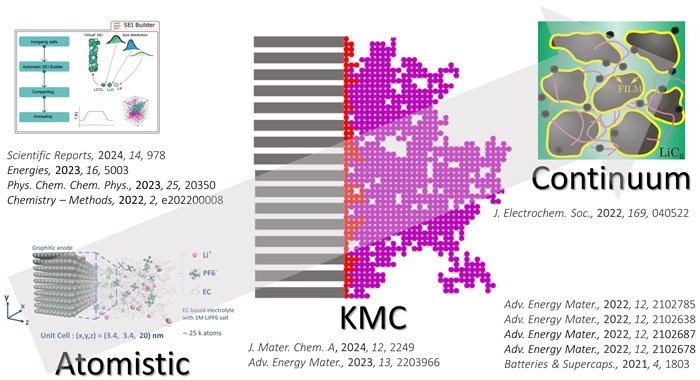With this key demonstrator we have pioneered a methodology to make cell level models at the micrometer scale aware of the molecular mechanisms that govern battery performance at the sub-nanometer level. Because there is not a single simulation method available that governs all relevant scales and processes we developed an integrated chain of modelling methods to conquer this problem. The cornerstone of our scale-bridging approach is a robust set of computational tools, consisting of two integral components: a dedicated set of chemistry-aware simulation methods and a state-of-the-art machine-learning toolkit. The elements of the resulting toolkit were made available in externalizable workflows using widely adopted workflow engines, such as AIIDA and SimStack, to facilitate seamless integration as a driver of materials acceleration platforms for batteries. Our tools enable co-discovery with experimental groups.

The solid electrolyte interphase (SEI) has a critical influence on battery life, performance, and safety, but is extremely hard to characterize by experiments alone. To aid experimental analysis and battery optimization, we developed a bottom-up multiscale approach to SEI formation based on the system-specific characterization of microscopic processes. Initially, we delivered an ASE-based application to replicate SEI microstructures based on a rationally designed initial SEI morphology at the atomic scale by stochastically arranging crystal grains of the inorganic salts that formed during the initial stages of SEI formation and Li-ion migration1,2. We developed reactive molecular dynamics simulations3 and kinetic Monte Carlo (KMC)4 protocols that model the spatiotemporal evolution of organic and inorganic SEI components governed by a set of chemical reactions, diffusion, and aggregation at nanometer resolution utilizing kinetic information computed for specific electrolyte-anode chemistries.
These novel mesoscale models were integrated with atomistic models for specific chemistries and continuum models to account for the microstructure of the battery cell. Combined, these techniques enable unprecedented insights into SEI formation and growth and electrolyte performance. The scale-bridging methodology has been made available in the BIG-MAP App Store. Employing machine learning tools, we have been able to construct surrogate models5 for the growth of the SEI for electrolyte and electrode performance that could potentially be employed in the context of increasingly autonomous experimental protocols for battery characterization optimization.
This approach to multi-scale scale-bridging transcends the boundaries of the BIG-MAP project. It serves as an essential component and template, to streamline in-silico battery research, to facility materials acceleration platforms and also enables the broader participation of the entire battery community.
References
(1) De Angelis, P.; Cappabianca, R.; Asinari, P.; Chiavazzo, E., SEI Builder - Jupyter notebooks to build inital SEI morphology.
(2) De Angelis, P.; Cappabianca, R.; Fasano, M.; Asinari, P.; Chiavazzo, E., Enhancing ReaxFF for Molecular Dynamics Simulations of Lithium-Ion Batteries: An Interactive Reparameterization Protocol. Sci Rep 2024, 14 (1), 978.
(3) Mabrouk, Y.; Safaei, N.; Hanke, F.; Carlsson, J. M.; Diddens, D.; Heuer, A., Reactive Molecular Dynamics Simulations of Lithium-Ion Battery Electrolyte Degradation. (Under Revision) 2024.
(4) Esmaeilpour, M.; Jana, S.; Li, H.; Soleymanibrojeni, M.; Wenzel, W., A Solution‐Mediated Pathway for the Growth of the Solid Electrolyte Interphase in Lithium‐Ion Batteries. Adv. Energy Mater. 2023, 13 (14), 2203966.
(5) Soleymanibrojeni, M.; Rego, C. R. C.; Esmaeilpour, M.; Wenzel, W. An Active Learning Approach to Model Solid-Electrolyte Interphase Formation in Li-Ion Batteries. J. Mat. Chem. A 2024, 12 (4), 2249–2266.